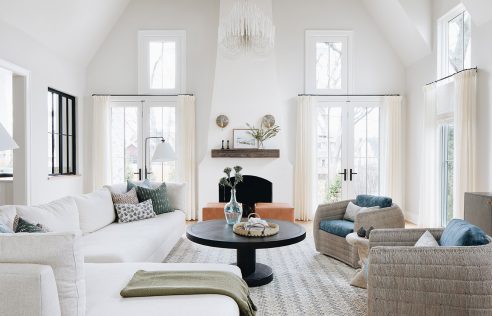Which Kitchen Layouts Should You Pick?
Contents
Questions to ask yourself before choosing your kitchen layout
The I-shaped kitchen
The L-shaped kitchen
The parallel kitchen
The U-shaped kitchen
The G-shaped kitchen
The kitchen with island
The ideal kitchen must be both aesthetic and functional, minimize movement and allow you to have everything within reach. To choose the layout of your kitchen, you must first decide on its location: I-shaped or linear, II-shaped or parallel, U-shaped, L-shaped, G-shaped or island.
The choice of the layout of your kitchen depends on different elements: technical constraints, the surface and volume of the room, as well as your needs in terms of appliances and worktop…
Questions to ask yourself before choosing your kitchen layout
Before designing your kitchen plan, you should ask yourself several questions in order to choose the plan that best suits your situation:
Do you need a functional kitchen?
Do you want a friendly place to entertain family and friends?
Do you like to cook or do you like to cook very little?
In addition, you must pay attention to technical constraints, because it is not always possible to modify the layout of the home and certain volumes constrain the choice of layout. You will also have to see what you need in terms of household appliances in order to plan the necessary space.
On the other hand, the activity triangle can help you organize your kitchen and choose the most appropriate layout. The triangle of activity in a kitchen is arranged around three poles:
Washing: sink, dishwasher and kitchen wastebasket.
Cold: refrigerator and freezer, if any.
Cooking: oven and hotplates.
The I-shaped kitchen
The I-shaped or linear kitchen is one of the most common layouts. All the functions are grouped along a single wall with elements in height. It is also known as a corridor kitchen because, in addition to being long, the I-shaped kitchen is often narrow.
When should I choose a linear kitchen plan?
The I-shaped kitchen is very functional and is popular with young people, singles and couples. It is also preferred for small apartments, where every square inch counts. This type of layout is also found in kitchens that open onto the living area, often combined with a kitchen island.
Note: you will need a minimum of 1.50 to 1.80 m in width (allow 60 to 70 cm for the width of the worktop, and between 90 cm and 1.2 m of passage).
The advantages of an I-shaped kitchen
Easy to fit out, the I-shaped kitchen can integrate all kitchen equipment with a standard format. It is also perfect for an open kitchen as well as for small and narrow areas.
It is compatible with small budgets.
The disadvantages of an I-shaped kitchen
With this layout, the activity triangle cannot be respected. Its layout does not provide for a large work surface either.
The elements are grouped together on the same wall to save space, so the appliances are reduced to a minimum. The majority of I-shaped kitchens integrate, for example, a “top” refrigerator (mini-fridge) or a built-in oven in the base units.
The L-shaped kitchen
The L-shaped kitchen is composed of two modules placed perpendicular to each other and forming an angle. This layout is very common in kitchens because it optimizes space and adapts to any atmosphere.
When to choose an L-shaped kitchen plan?

This is the most common kitchen layout. It is mainly found in square or rectangular kitchens. Moreover, it is perfect for areas between 10 and 15 m² and beyond.
The advantages of an L-shaped kitchen
The triangle of activity is perfectly respected and movements are limited from one pole to another.
This arrangement also allows for a large work surface. When space permits, the L-shaped kitchen can be both open and closed and can easily have a dining area.
The disadvantages of an L-shaped kitchen
The disadvantage of an L-shaped layout is the famous corner. In this corner, it is not advisable to place the sink and the cooking plate. However, today’s kitchen designers offer a wide range of corner cabinets.
On the other hand, it is necessary to have a room wide enough to receive this type of kitchen, because the return (1.20 m) will not be large enough and the circulation space will be reduced.
The parallel kitchen
A parallel or II kitchen is a variation of the linear kitchen. To install your parallel kitchen, you need to have two walls facing each other. The elements are then arranged at the bottom or top of the walls.
When should I choose a parallel kitchen plan?
This type of layout is suitable for closed kitchens, whose surface area can be between 10 and 15 m². The space left must allow for the arrangement of kitchen elements on two parallel walls. Often, the space is crossing with, on one side, the door and, opposite, a window.
To allow two people to pass each other, plan for a minimum of 1.20 m of central circulation.
The advantages of a parallel kitchen
With a parallel kitchen, it is easily possible to set up the activity triangle to ensure a fluid and easy circulation between the different areas of the kitchen. The work surface is large, and it is possible to arrange numerous storage modules.
It adapts to different surfaces and lifestyles.
The disadvantages of a parallel kitchen
The only disadvantage of this type of installation is that it is mainly inserted in a closed kitchen, a configuration that is not very present on the market since the fashion for open kitchens.
On the other hand, it is not adapted to narrow kitchens.
The U-shaped kitchen
To create a U-shaped kitchen, you can either occupy all three walls of your room by integrating all the elements, or you can install elements on two contiguous walls and complete the layout with a dining area. Whatever your choice, it is advisable to place your sink in the center of the U, in order to respect the triangle of activity. In the logical continuation, the storage elements are located at the end of the plan, on the sides.
When should I choose a U-shaped kitchen plan?
The U-shaped kitchen can be adapted to any surface and any atmosphere. Moreover, you can install it in a closed or open kitchen.
Good to know: it is nevertheless advised to have a consequent central space of at least 1,20 m, even 1,50 m (between the two parallel sides).
The advantages of a U-shaped kitchen
With three adjoining shelves, the U-shaped kitchen makes it easier to set up the activity triangle.
It is spacious, ergonomic and ideal for a kitchen that opens onto a living room.
The disadvantages of a U-shaped kitchen
Be careful with corners, as they can often waste space. Fortunately, however, kitchen designers now offer many corner storage units.
In addition, the width of the kitchen should ideally be 2.70 m and include two 60 cm modules on each side, and 1.50 m of circulation space.
The G-shaped kitchen
The G-shaped layout is a variant of the U-shaped kitchen with either a bar return or an extension of the worktop.
When should I choose a G-shaped kitchen plan?
G-shaped kitchens are mainly used in open kitchens with a width of at least 2.70 m.
The advantages of a G-shaped kitchen
The G-shaped kitchen is friendly and open to the living room. It often has a large surface area and offers the possibility of creating a dining area.
The disadvantages of a G-shaped kitchen
The major disadvantage is that the G-shaped kitchen requires an open kitchen.
The kitchen with an island
Today, the kitchen, a family and convivial place, is very often associated with an island. Very popular and trendy, it offers many functional and aesthetic advantages. Whether it’s a simple storage unit or a multifunctional unit, it allows you to enlarge your kitchen space.
When to choose a kitchen plan with an island?
The kitchen island is suitable for large kitchens with a linear I- or L-shaped top, as its installation requires the ability to move around. Therefore, plan for a minimum space of 90 cm, or even 1.20 m for two people to pass each other.
The advantages of an island
The island allows you to increase the surface area of the work surface and storage space, and can be used as a dining area. It is a design and convivial element that every modern kitchen would like to have.
The activity triangle is optimized and ergonomic.
The disadvantages of an island
The installation of a central kitchen island can be technically difficult because of the plumbing and electrical connections. In the case of an island with a sink, it is often necessary to install the water supply in the center of the room. This means that major work is required.
For the installation of an island with technical elements, it is necessary to foresee a higher budget compared to other implementations.



Pingback: What Thermal Insulation For False Ceiling? | MyHome